Programme 8-9 am: Registration 9 – 10.30 am: Inaugural Session Chair and Welcome address: Dr.…
Recent Structural Change in the Indian Economy C. P. Chandrasekhar and Jayati Ghosh
The newly-released India Employment Report 2024, produced by the ILO and the Institute for Human Development, contains a wealth of information and analysis on past and current employment patterns, and has an important focus on employment concerns of the youth in India. The report makes for grim reading, which should come as no surprise to anyone even minimally familiar with the sluggish job market and the Indian economy’s apparent inability to generate more good quality jobs.
But there is another aspect of the findings in the report that deserves greater consideration: the perverse trends of structural change in recent years, which should also be of great concern to policy makers. One of the major failings of the Indian economic development process has been the inability to move workers out of low-productivity, low-paying activities in the primary sector (agriculture, forestry, fishing, etc.) and in low-remuneration services. The most recent period is marked not just by continued stagnation in this respect, but even a slight worsening.
Figure 1
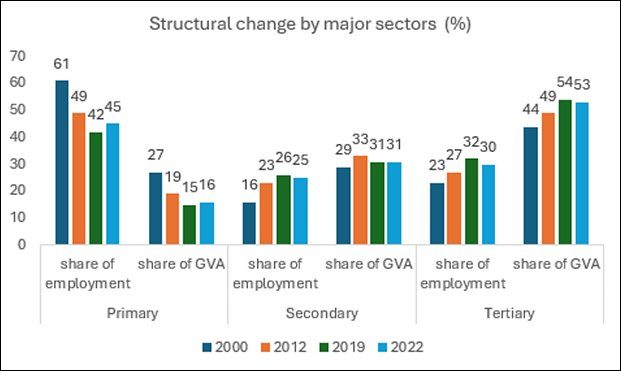
Source for all figures: India Employment Report 2024, ILO and IHD.
Figure 1 shows the changes from 2000 to 2022. (It should be noted that the calendar years actually refer to the period from July the previous year to June of the stated year, in accordance with NSSP surveys on which the data are based.) 2022 was the year when the Indian economy was still recovering from the Covid-19 pandemic; even so, the increase in the share of workers in primary activities (from 42 per cent in 2019 to 45 per cent in 2022) comes as a shock.
This shows that agriculture still remains a “refuge” sector for workers, in the absence of adequate employment generation in other sectors, and that underemployment still remains very marked in India, even taking into account the low aggregate employment rates. Indeed, primary activities dominate in rural areas and service activities in urban areas, both accounting for 60 per cent of total employment in the respective locations.
The share of secondary employment increased continuously between 2000 and 2019, but then fell to 25 per cent in 2022. This requires further investigation. Figure 2 disaggregates the two most important sub-sectors within secondary activities, manufacturing and construction.
Figure 2.
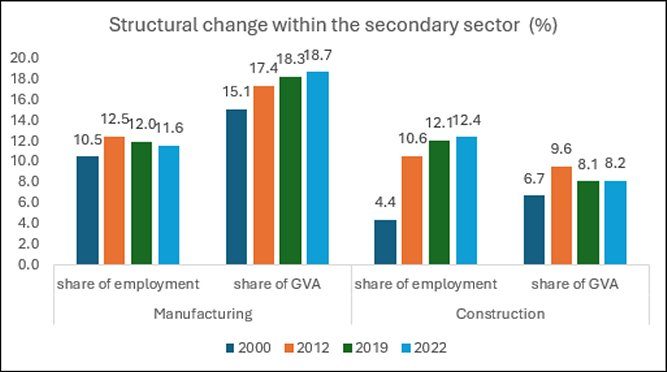
It turns out that the increase in secondary employment after 2000 was not largely due to manufacturing. The declining shares of manufacturing in total employment are evident from 2012 onwards, even as the share of manufacturing in GVA increased slightly (but still remained well below one-fifth). However, construction increased its share of employment quite sharply, such that by 2022, for the first time in the Indian economy, the share of workers employed in construction outnumbered those in manufacturing. In turn, much of the recent increase in construction—in both output and employment terms—has been because of public investment, as private investment in this sector has lagged in recent years.
This breakdown of the anticipated Kuznets-Lewis process of structural change is also evident in the employment pattern, which shows little evidence of the formalization predicted by such theories. Figure 3 indicates that regular employment did increase from 14 per cent in 2000 to 24 per cent in 2019, but subsequently fell again to 22 per cent. Much of that increase, however, was in types of work that cannot be considered formal, such as employment for domestic services in private homes. The report notes that formal employment ratios barely changed at all, going from 8.5 per cent of total employment to only 10.5 per cent in 2019, then falling to 9.7 per cent in 2022. What is also striking is the decline in casual work, which has been balanced not by increases in regular employment, but in self-employment. This is a real comment on the absence of real job opportunities in the labour market, which has forced so many workers into what is euphemistically called “micro-entrepreneurship”.
Figure 3.
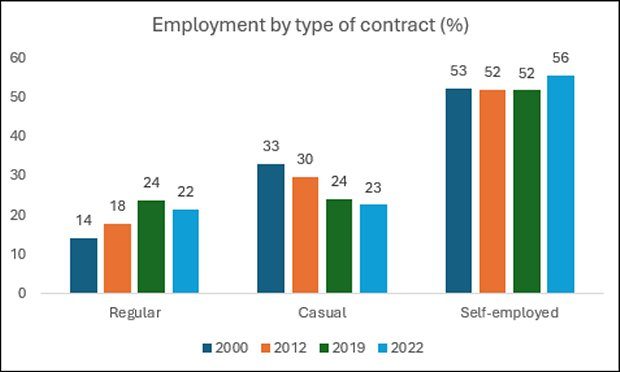
Figure 4.
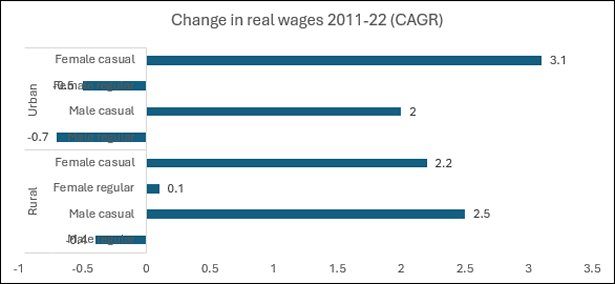
These depressing trends help to explain the broader stagnation of real wages, particularly in the last decade, which has been confirmed by other data sources as well. Figure 4 shows the annual growth in real wages. Shockingly, real wages actually declined for both male and female regular workers in both rural and urban areas, despite the much-hyped growth of the economy over this period. For casual workers, the real wage increases were very low, and well below the rate of increase in per capita GDP. Indeed, there were barely noticeable for female casual workers in rural areas. This is further evidence of the significant increase in inequality in India especially since 2014, that has also been documented by researchers at the World Inequality Lab.
Figure 5.
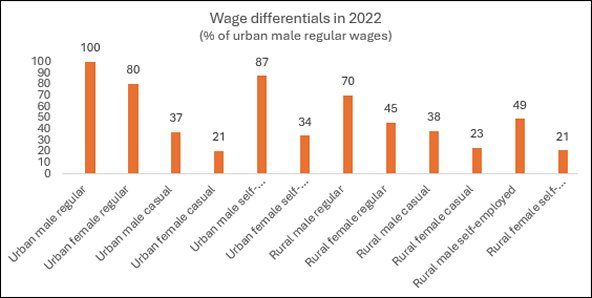
While workers as a whole have not benefited from recent aggregate economic growth, inequality is evident even between workers, as Figure 5 illustrates. While wages of regular workers have fallen in real terms, they are still significantly higher than the earnings of all other types of workers. The worst situation is of women workers: female casual workers and self-employed women earn only around one-fifth of the wages received by men working in regular employment in urban areas.
In most countries, a report—and a reality—such as this would generate massive public and official concern. However, the current government seems to think this is not their problem: at the release of this report, the government’s Chief Economic Advisor V Anantha Nageswaran actually declared that the government cannot solve all social and economic problems, such as unemployment! This is counter to the promise of one crore new jobs for the youth of the country made by Narendra Modi during his 2013-14 electoral campaign, and the BJP’s 2014 and 2019 election manifestos. This is clearly another area in which “Modi ki guarantee” has not worked.
As the country enters yet another general election process, we have yet to see whether this employment crisis will be given the importance it deserves by the electorate.
(This article was originally published in the Business Line on April 3, 2024)
